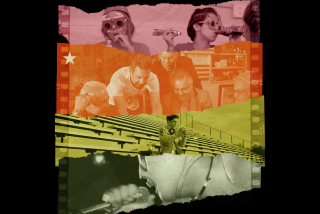Tijuana’s Busy Cultural Center Marks 6th Year
- Share via
TIJUANA — Six years ago, Tijuanans were highly disappointed with the Oct. 20 inauguration of the Tijuana Cultural Center. “They feared they’d be stranded with a white elephant,” said current center director Rodolfo Pataki.
Time proved the natives wrong, and the center is constantly busy with performances. On its anniversary Thursday, the center presented the world’s finest classical guitar concert artist, Narciso Yepes. The same day marked the inauguration of a Huichol Indian art exhibit that was shown at the San Diego Museum of Man two years ago.
“We are not celebrating for one day, but for the whole month,” Pataki said. October programming has featured plays, music and five international shows borrowed from the Cervantes International Festival now being held in Guanajuato, in central Mexico.
“We decided on Yepes because there is a classical guitar tradition in Tijuana and lots of aficionados,” Pataki said. “Now, I am not saying that people were elbowing each other to hear Yepes, but the first performance was sold out beforehand. We expect that the second performance will also get a good crowd on word-of-mouth publicity.”
Yepes played his 10-string guitar Thursday and Friday.
Pataki recalls that changes in the federal Mexican government made the difference between the cultural center being a tourist-oriented attraction or a community service theater. At first, the center was operated by the tourism secretariat, but, in 1983, it was taken over by the public education secretariat.
Pataki says the secretariat for public education has emphasized theater programs for children and claims that most of Tijuana’s children have seen live performances there.
“We are educating an audience,” he said.
The total of paid tickets to the center’s several entertainment facilities is put by Pataki at 3.5 million in the last six years--1.2 million of them this year.
Besides the main 1,000-seat theater, the center has an Omnimax movie house (popularly known as la bola for its round shape), a museum, a restaurant and a seldom-used outdoor theater.
Programming for October has included plays and music as well as a Columbus Day celebration, and still coming up are music and dance programs including Jose Maria Vitier from Cuba with Latin jazz tonight; Sosta Palimzi, an Italian modern dance company, Monday, and Danza Hoy, a contemporary dance ensemble from Venezuela, on Tuesday.
“These groups performed in Guanajuato in the Cervantes International Festival,” Pataki said, “but we brought them over because of their high quality.”
Beyond bringing world-class performers to Tijuana, Pataki believes the cultural center has enhanced the often rough relationship between Tijuana and San Diego.
“We have enjoyed a lot of contributions from San Diego art groups and orchestras,” he said. “We believe that our cultural exchange is fruitful.”
Next Saturday, the United States International University Orchestra will play an “Only Mozart” program conducted by Zoltan Rozsnyai. “It will be the last performance of the October Festival we are having, and it is only fitting that we do it with a regional orchestra,” Pataki said.
Despite the Tijuana Cultural Center’s success, some unhappy local artists still feel they are not sharing in the center’s finest moments. According to one theater director, the center is “bringing in all sorts of fancy shows but doing little to promote local arts.”
Jorge Andres Fernandez, a local stage director, says the center needs to go beyond being an impresario and “help us develop professionally.” Fernandez has been the only director to receive a full production budget at the center.
He staged “Peter and the Wolf” there in 1984, which was seen by a record 100,000 children. Since then, neither Fernandez’s nor other theater groups have received financial aid from the center.
“We should be doing great theater productions in that wonderful theater,” Fernandez said, “but the fact is that we are not.”
Pataki says this year the center is helping finance three children’s productions. But those productions have been lambasted by drama critics as lackluster and amateurish.
The center, however, says Pataki, has welcomed all of Tijuana’s dance and theater groups on its stage, a fact no one will deny.
“But what’s the use if we go and perform there with our poor productions?” said Fernandez, who performed in the U.S.-made movie “Born in East L.A.”
“They have to help us develop local artists, and stop importing productions, no matter how good they are.”
Pataki defends the practice as a practical measure, because local productions do not draw crowds, while “imported” productions do. He also said that, with the popularity of imported productions, “people here are really developing a taste for the performing arts, which they did not have before.”
More to Read
Sign up for Essential California
The most important California stories and recommendations in your inbox every morning.
You may occasionally receive promotional content from the Los Angeles Times.










